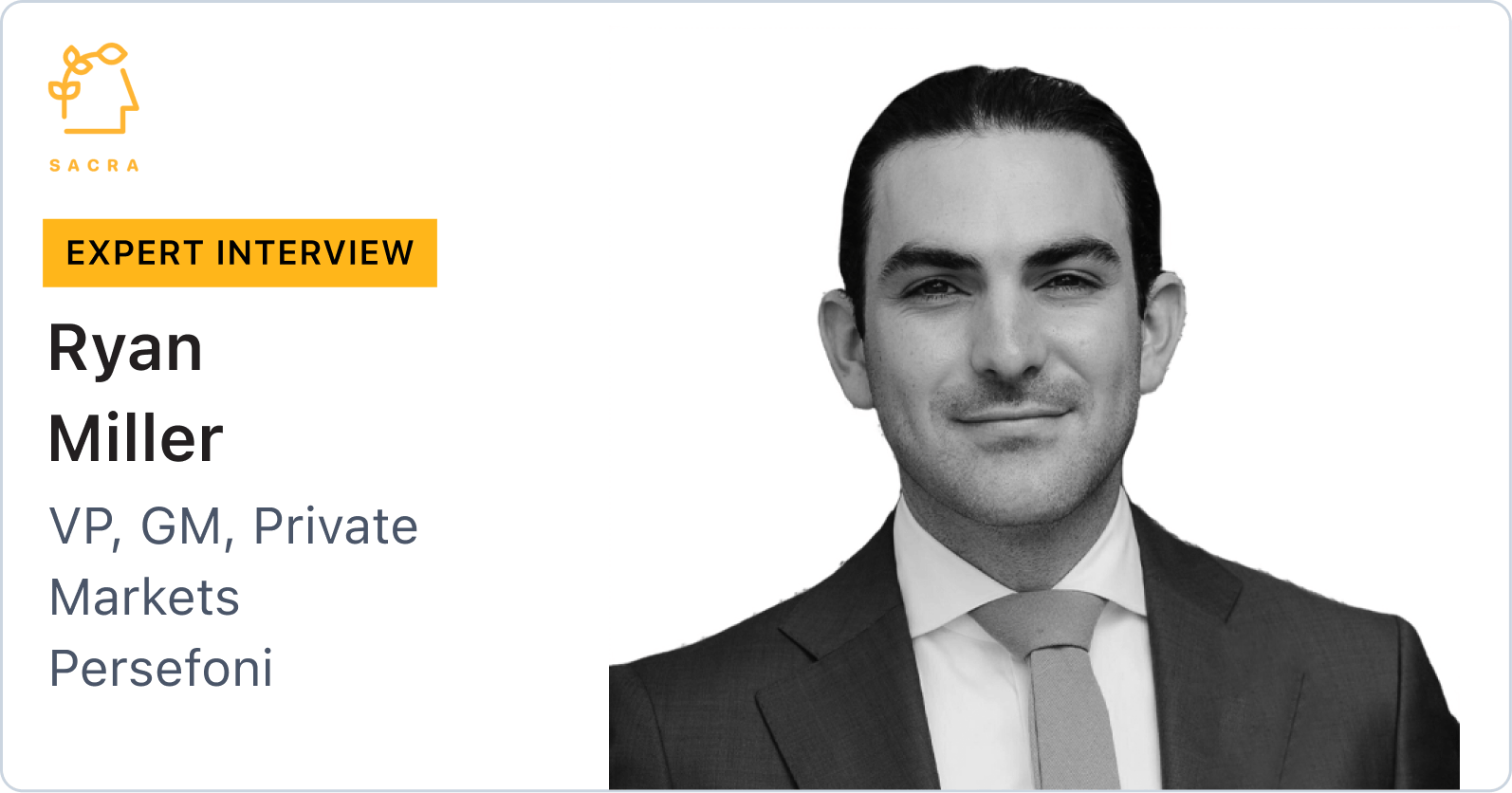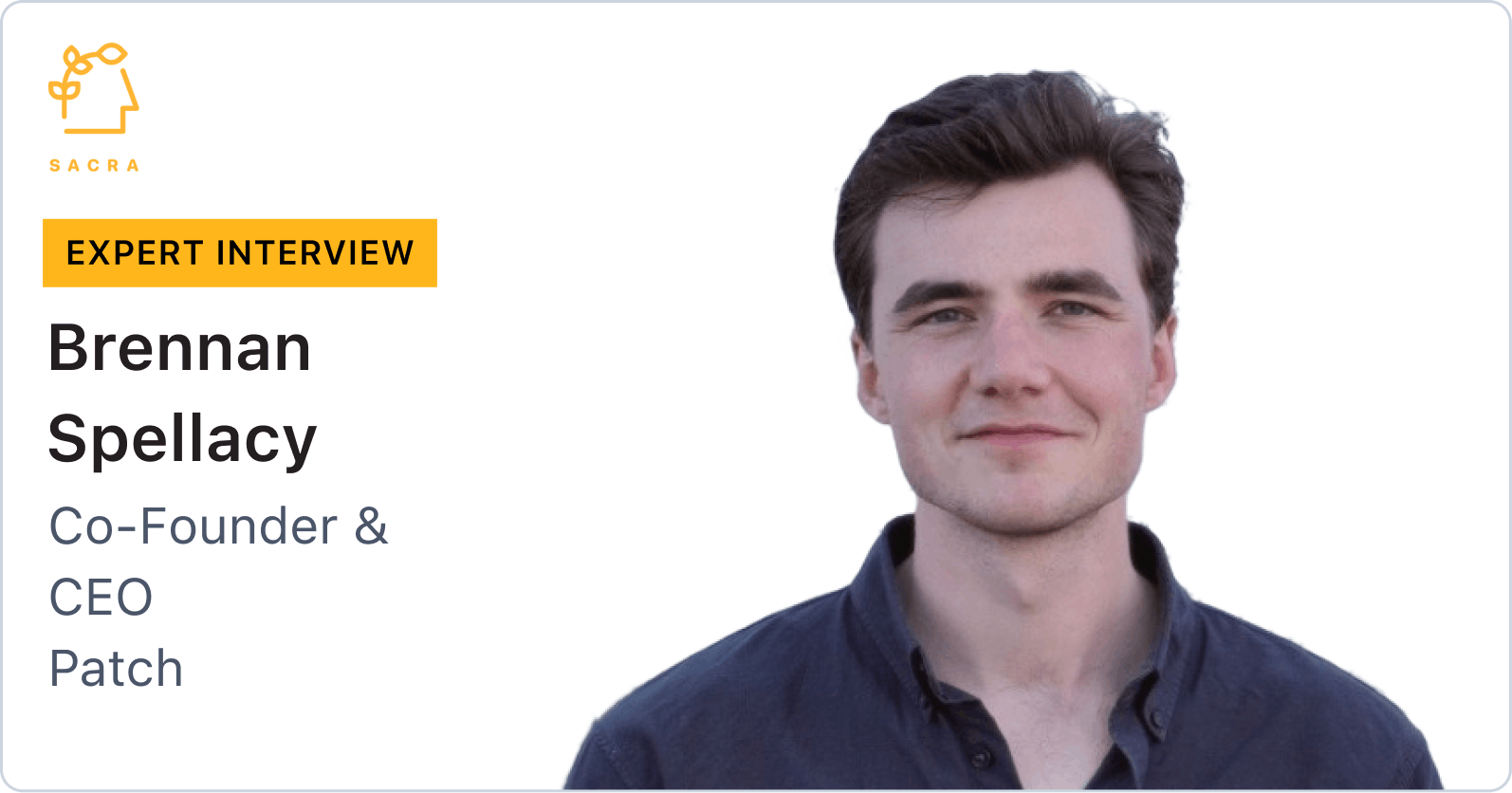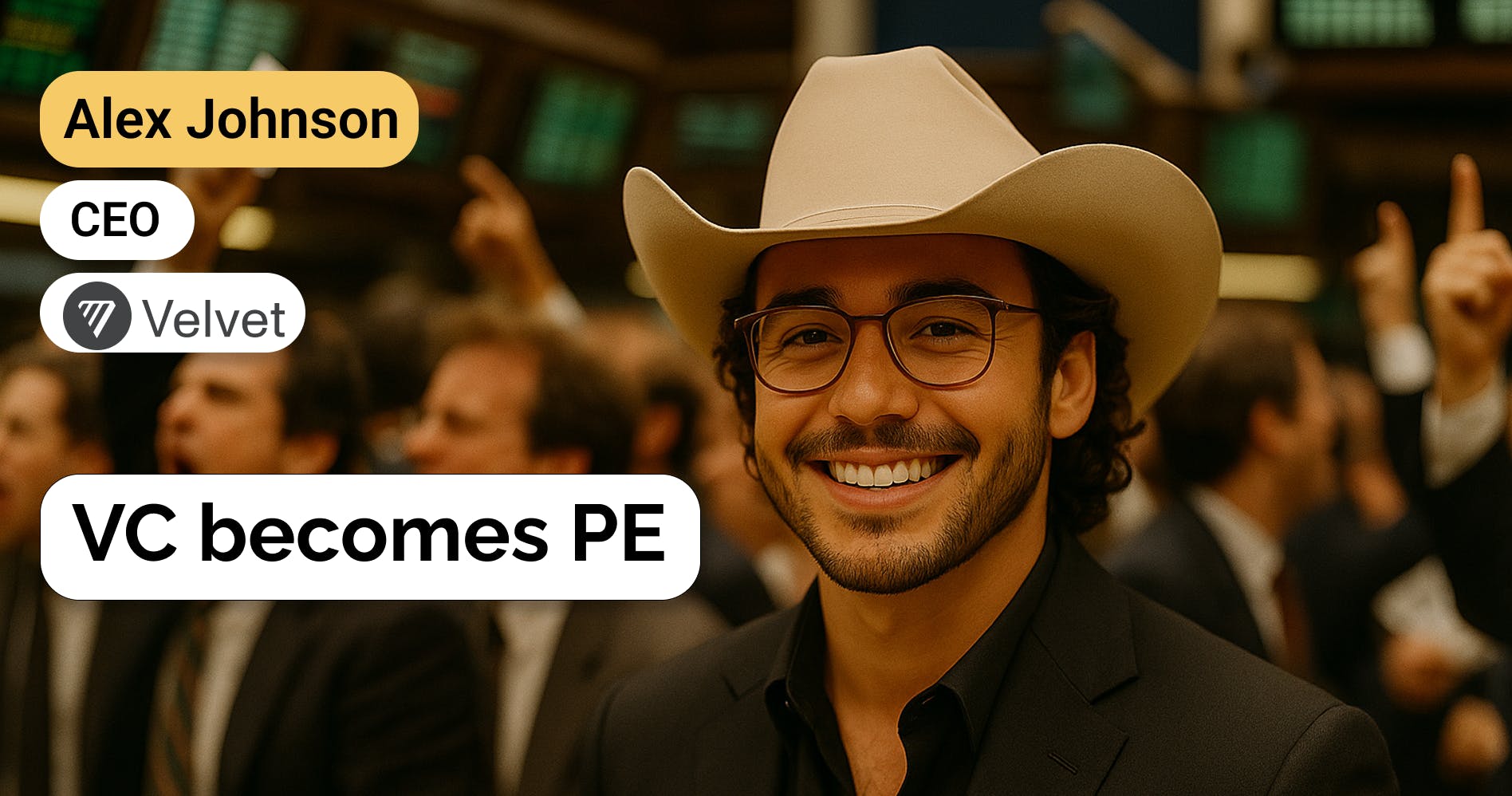Ryan Miller, VP & GM of Private Markets at Persefoni, on building an ERP for carbon
 Jan-Erik Asplund
Jan-Erik Asplund

Background
Ryan Miller is the VP and GM of Private Markets at Persefoni. We talked to Ryan because carbon accounting is emerging as a key need for companies and funds looking to comply with ESG mandates from their shareholders, strengthen trust and affinity with environmentally-conscious consumers, and get into compliance with guidance from governmental organizations like the SEC.
Questions
- Can you start off by explaining what Persefoni is, the problem you're solving, and some of the core use cases that you're seeing?
- The introduction of GDPR and CCPA was a big catalyst for companies to build software for security compliance. Was there a similar catalyst for Persefoni and this kind of carbon accounting technology?
- In other words, you’re thinking that this kind of carbon accounting will go from a cost of doing business to being a driver of value for more businesses?
- I'm curious to what extent you're seeing that or inklings of that kind of shift happening now. Are there companies in particular that are good examples of this today?
- What's made this kind of shift slow to emerge? Why haven’t we seen more products and companies espousing their low carbon emissions in the decades since Al Gore and An Inconvenient Truth?
- If you take a Fortune 100 company, who's in charge of making sure that this all happens?
- It’d be great to understand better how the work of carbon accounting works for companies doing it the old way—how much time and money it takes.
- Do you imagine a future where even small direct-to-consumer businesses advertising on social media are using their carbon footprint to market themselves to consumers?
- You charge on a recurring, SaaS basis—what is the basis for customers’ ongoing re-engagement with the product?
- Who in an organization is touching Persefoni? Who are some of the big personas you have in mind for who's using the product?
- How do you think about the positioning of Persefoni with respect to other companies in the space like Measurabl, Watershed, EcoVadis, Sylvera, and Sweep?
- How you think about partnering with other companies? How do you think about partnerships as a win-win for Persefoni?
- One thing that I didn't think of is having these two big consultancies as partners is interesting. Because it makes me think of Carta, the cap table management software. They replaced what the lawyers do to a large degree, and they found that instead of hating them for that, lawyers actually loved it because that took that part of their job away. Is that a similar kind of dynamic with consultants, actually liking what you do versus stealing their business?
- In five years' time, if everything goes correctly, if everything goes right for Persefoni, what does the company look like? What does the world look like?
Interview
Can you start off by explaining what Persefoni is, the problem you're solving, and some of the core use cases that you're seeing?
Persefoni is a climate management and accounting platform, or CMAP. The company's been around for about two years. Today, it's about 250 people, mostly remote, headquartered in Tempe, Arizona. We raised a Series B in October of last year that was $101 million.
We're certainly still in the scale-up phase, but the team got started with one pretty clear goal in mind. Carbon accounting has historically been a pretty manual process, done by consultants on spreadsheets, and thus pretty limited to the largest companies that had resources to spend on that. We’re moving it to being software-based and building “the ERP for carbon.”
Today, there are really two core use cases that we're in the market with.
One use case is surveying a company that wants to calculate its carbon footprint. It's pretty simple. They want to calculate their carbon footprint in line with the Greenhouse Gas Protocol Corporate Standard, but they’re looking for a software solution to do it. That could be a company calculating its footprint for the first time, and they want to use software, or it could be a company that's been calculating its footprint for years, but they've been doing it manually, and they want to move software.
The second use case is calculating the footprints of investment portfolios. That could be stocks, bonds, private equity investments, real estate, infrastructure projects, finance, commercial mortgages, or motor vehicle loans.
That's being done in alignment with a standard called the Partnership for Carbon Accounting Financials or PCAF for short, which is a subsidiary standard under the Greenhouse Gas Protocol, which governs the calculation of this area of financed emission, so carbon footprint from an investment portfolio.
These are two connected but slightly different use cases with slightly different goals.
A company might want to calculate their footprint because they're required to by regulation, because they want to differentiate from their competitors, or because it's important to their brand.
An investor might want to calculate their footprint because they're required to by regulation, which is increasingly happening, but also because they want to show their investors, their stakeholders, that they're taking climate change seriously, that they're taking action on carbon emissions.
The introduction of GDPR and CCPA was a big catalyst for companies to build software for security compliance. Was there a similar catalyst for Persefoni and this kind of carbon accounting technology?
People do draw parallels between the ESG space and the privacy space because they're areas where companies have had to scale up their ability to respond over the past decade, sometimes in line with market trends and sometimes in line with regulations.
When you look at GDPR and the impact that had on the privacy software space, there are similar trends in the carbon emissions and climate change space. In Europe, the Corporate Sustainability Reporting Directive (CSRD) is the core regulation. That’s going to require about 5,000 companies to to calculate their carbon footprint.
In Japan, the Japanese Financial Services Agency (JFSA), the primary financial regulator, is looking at about the top 12,000 companies that are required to calculate their footprint.
Then, of course, most recently, it's the SEC's proposed rule, which is only about a week-and-a-half old, but which is looking to have the largest 3000 public companies in the U.S. calculate their carbon footprint over the next few years as well.
So yes—there are definitely regulatory drivers, and there are great parallels to be made there between privacy and between ESG.
At the same time, I sometimes draw a distinction between the two.
When you think about privacy and security, yes, there is this regulatory driver, but a lot of companies look at that as somewhat adjacent to their core business. It's not core to their operations. It's not core to their success. It's something that they have to manage adjacently to make sure that they don't get into trouble.
I think there are people who view ESG that way. But there's also a really growing community that views ESG as, actually, a core measure of success. When you think about business performance, you think about financial performance. But increasingly, organizations are also thinking about their impact on their stakeholders, their impact on the environment, their impact on people, climate change being the most urgent of those crises, and carbon emissions being the most quantifiable piece of climate change.
If I look five years into the future, I think that there will still be privacy and security and probably other areas of compliance that are being managed well. But then I think on top of that, there will be financial performance, financial success, ESG and climate change performance, and ESG and climate change success.
That's why we think that the greatest comparison between Persefoni and climate accounting and another trend in software is actually the growth in enterprise financial software, the NetSuites, and SAPs, and even to a lesser extent, the QuickBooks of the world, because they helped move financial accounting from being manual and purely spreadsheet-based to being governed by a cloud SaaS platform.
In other words, you’re thinking that this kind of carbon accounting will go from a cost of doing business to being a driver of value for more businesses?
When you look at organizations in the future, there will be a number of reasons why you think about managing your carbon emissions.
Yes, regulation may be one of those reasons, but you also will be looking at how you’re viewed by the public and by public markets investors. Emissions will be a differentiator when you go to negotiate contracts with enterprise customers. You’ll have the ability to achieve lending terms that are more favorable based on your carbon and climate performance. You’ll have a better ability to attract talent.
I think there are numerous value-accretive areas where managing carbon emissions and managing climate change will come in.
I'm curious to what extent you're seeing that or inklings of that kind of shift happening now. Are there companies in particular that are good examples of this today?
When you look at the last few years from a macro perspective, there's been incredible growth in the amount of sustainable debt issuance generally. One of the largest trends in the financial sector is the increase in sustainable debt. When you look at those sustainable debt terms, the most common metric that they are tied to is carbon emissions because among ESG areas, that is generally the most easily quantifiable. It also tends to be one of the most impactful. That’s still a tiny sliver of the overall debt market, but it's growing for sure.
What you'll also see, as that grows in importance, is the premium—the reduction in the interest rate that you'll be able to get from having a low-carbon business will grow as well. Today, it's tiny, but it’ll grow.
When you look at the corporate space, there are a lot of companies over the past five years that have grown significantly on the value proposition that they are a lower-carbon alternative to a more traditional product or service. Allbirds is a great example. They went through what they dubbed the sustainable public offering, or SPO. They were a leader in tagging their footwear, at the product level, in terms of the carbon footprint of each individual shoe. You hadn't really seen that much before, and it’s a core part of their value proposition.
Impossible Foods is another one—another great example of a product that a lot of people enjoy that also gained prominence in part because it was an alternative to a much more carbon-intensive product, which is regular beef.
What's made this kind of shift slow to emerge? Why haven’t we seen more products and companies espousing their low carbon emissions in the decades since Al Gore and An Inconvenient Truth?
When you look at the last two decades, one of the things that has really changed is the visibility of the climate crisis. At the time An Inconvenient Truth was published, Al Gore famously had to go up that elevated platform to show how carbon emissions were going off the chart.
But it was still a chart. It was still a number that was somewhat abstract. Today, you look at the pace of extreme weather events, fires, droughts, flooding, the beginning of sea level rise, and all these very tangible impacts of climate change. As a result, you're really seeing a renaissance in the way people have viewed climate change over even the last five years, driven by the visibility of these crises.
Why has carbon accounting not hit the mainstream yet? I think it comes back to it being really tough.
When you look at traditional financial accounting, there's a max of 10 calculations that you have to go through. Everything you're doing is denominated in currency, whether dollars or euros or pounds—maybe you have to do some conversions, but it's still all currency.
When you look at the field of carbon accounting, even just corporate carbon accounting, there are 260 different calculations that you have to complete, and all those calculations have a different denomination. They're all coming from different areas.
There are the gallons of fuel that you burn at a facility on-site and the kilowatt-hours of electricity that you purchase from Con Edison. There are the pounds of cotton for Allbirds that go into their shoes, and there’s the miles that UPS ships that shoe to the end-consumer, and it's the consumer tossing that shoe in a landfill at the end of its life, and the carbon footprint of that disposal.
All of those pieces are different and they all have to be accounted for differently. The conversions you have to make are all different, so it's really complicated, which means two things.
One, there's been a huge barrier to companies doing this, which is why you have not seen it go mainstream.
Two, it's a space that is incredibly ripe for software. If you do the work to build out these calculations into software that you can then scale close to zero marginal cost, you can take something that was behind the gates and only available to the largest of large companies, and you can make it something that millions of small businesses can do now with a software platform.
If you take a Fortune 100 company, who's in charge of making sure that this all happens?
I'd separate it into two questions: there’s who was in charge, and there’s who will be in charge.
When you look back, historically, carbon accounting generally sat in a sustainability office, sometimes labeled an ESG office. It was thought of as part of the broader ESG picture, the broader sustainability picture, which also meant that it was chronically underfunded as an area of focus.
Now, with the regulatory changes and the compliance changes, but also with this being something that can be value accretive, what we're increasingly seeing is that it's moving into the office of the CFO.
When we think about carbon accounting in the future, it’s something that’s going to be managed in the office of the CFO.
Will there be sustainability team members that are stakeholders? Absolutely.
Will there be procurement supply chain team members that are stakeholders? For sure, because it has huge implications for their strategic decision making.
Will it be something that the CEO, COO, and the board has visibility into? Absolutely, because, as I mentioned earlier, I think it will be a key metric of success. But who will have ultimate accountability for making sure it gets done? We're increasingly seeing that move to the office of the CFO.
It’d be great to understand better how the work of carbon accounting works for companies doing it the old way—how much time and money it takes.
What it looks like today is you would go to a company, and you'd have a conversation with them about their operations to understand the components of their footprint that might be relevant. That could be their facilities, parts of their supply chain, business, travel, employee commuting—all these different areas that can generate a footprint.
Then you would go from area to area, aggregating data from those business units so that you can start turning it into a carbon footprint.
That still has to happen. You can't replace that piece. Carbon footprint, at its core, is still a data-based challenge. You have to go to stakeholders across the company to gather data that can help you turn it into a carbon footprint. But what used to happen is then a consultant would take that data and they would match it up with what's called an emissions factor. That means taking that gallon of fuel, that kilowatt-hour of electricity, that pound of cotton, and then turning it into metric tons of CO2 equivalent.
There are a couple of calculations that happen in between, but I'm simplifying.
That was the domain of the consultant. They would go find the data from the company. They would find the emission factors. They would help complete the calculations. They would roll that all up.
That's something that can be replaced by software. At Persefoni, we built the software to contain both the calculations necessary to turn what's called activity data from the company into carbon footprint and also the emissions factor.
Historically, the SEC’s research shows that the cost of carbon accounting—when you include the direct cost and the labor costs—was somewhere between $490,000-$650,000
While that's not the largest cost on a Fortune 500 company's income statement, that is a significant cost when you start thinking about middle-market companies.
As you can drive down the cost of that carbon accounting process with software, that's how you can really make it a lot more accessible to small and medium businesses.
We're doing our part on that as well. We've announced that this year, we'll be releasing a free version of the Persefoni platform, which is targeted toward small and medium businesses. Sometimes, we jokingly say it's a TurboTax-like experience. We think that's going to be really important to enable those thousands and thousands of companies over the next decade that will need to calculate their footprint.
Do you imagine a future where even small direct-to-consumer businesses advertising on social media are using their carbon footprint to market themselves to consumers?
When you think about a direct-to-consumer business where you, the consumer, may be motivated in part to make that purchasing decision on the basis of sustainability, you can absolutely see a boom in this.
You can have companies rapidly calculate the carbon footprint of shipping options and displaying that to a consumer and saying, "Sure, if you want your products in two days, here's the carbon footprint. And if you're willing to wait a week, here's the carbon footprint." We're already seeing businesses integrating that kind of technology into their platforms.
An important piece of that is consumer buying behavior. We have certainly seen consumers' awareness of sustainability and its impacts on the buying decision grow over the last decade, but does it dwarf pricing concerns or quality concerns? Most research today says, “Not exactly.”
Is it a comparative advantage when you're looking at two products that are the same price or the same quality? Absolutely. It absolutely is. We'll see if, over the next decade, that flips and sustainability becomes one of the core buying criteria and not a comparative advantage.
You charge on a recurring, SaaS basis—what is the basis for customers’ ongoing re-engagement with the product?
Generally, the compliance standards we’re talking about require annual reporting. Will that be quarterly at some point in the future? It's possible. But we do think that even now, there are reasons you would engage with a carbon accounting process more frequently than just annually.
Just compare carbon accounting to financial accounting. Anybody who has managed a balance sheet or an income statement knows that the more frequently you update it, the less overall time you have to spend on it.
If you wait till month-end to deal with all of your expenses, if you wait till quarter-end to do all of your cash to accrual reconciliation, if you wait till the year-end to deal with tax receipts, it all gets really complicated and confusing.
We always coach our customers at Persefoni that you should think about carbon accounting similarly. Put it on a monthly or quarterly-close basis. That way, you’re taking the data that was generated over that past month or quarter and you're building it into your carbon accounting process. You're flexing that muscle continuously, and you're not scrambling at year-end to bring it all back together.
The other thing is that as we start talking about carbon reduction, decarbonization, net zero commitments, and science-based targets, then you can't make your best strategic decisions if you're only considering your emissions on an annual basis.
You have to look at it in closer to real time to make decisions around supply chain and procurement and shipping and business travel and strategic allocation of capital.
That’s the only way that you can start to really see year-on-year reductions in carbon footprint. Once that becomes even more common, I think we'll see companies that are not operating in the software monthly or quarterly or annually; they'll be operating it on a daily basis because they're using it to inform their strategic decisions.
Who in an organization is touching Persefoni? Who are some of the big personas you have in mind for who's using the product?
You have to think about both input and output when you think about personas.
On the input side, that’s where the CFO tends to get really involved because a lot of the data that lives across an organization finds its way back to the CFO in some form or fashion.
Sometimes, organizations will have an office of data management or data transformation, and those will be really interesting stakeholders as well for data input.
Then, of course, you're going to draw on the resources, probably across departments, for getting the data you need—from supply chain and procurement to human resources, to facilities.
When you start thinking about outputs, that's where I think the stakeholders start to shift more toward a sustainability office, who might be setting strategic goals around decarbonization, to the Office of the CEO, who's using it to inform board-level conversations.
The office of the CFO is certainly still involved there when it comes to making improvements on data collection, reporting transparency over time, and also tying it back to financial success, which means the office of the CFO is an important stakeholder on the output side too.
How do you think about the positioning of Persefoni with respect to other companies in the space like Measurabl, Watershed, EcoVadis, Sylvera, and Sweep?
It's a really interesting group of companies. They are all broadly in the ESG space, and we know all of them well. I think there are some that we would see as very complementary and some that we see as peers.
When you look at EcoVadis, what they've done in terms of motivating large enterprises to be able to gather a holistic amount of ESG data from their supply chains has been really impressive. They've made incredible strides in that space. We see carbon accounting as absolutely complimentary to that, and we know that team well.
We see Sylvera as very complementary. Sylvera is much more focused on the carbon offset space, which is kind of after you've done your carbon accounting, after you've set a climate change strategy, after you've reduced your carbon footprint, it maybe offsets that last piece that gets you toward truly net zero.
Sweep just raised a big round, and Watershed raised a large round recently. Those are certainly peer companies in our space.
We think our differentiators continue to be that we are the largest and best-funded carbon accounting startup that's been doing it the longest.
We have built out what we believe is the best solution for carbon accounting for the purposes that we're talking about: transparency and disclosure, auditability, and because of our work in the financial services space, the ability to report on the connection between a corporation and its investors.
We absolutely see those as core reasons why we've been successful in the marketplace. But we know those teams well, and one of the things that's nice about the broad ESG space is that companies like working together because almost all of us are mission-motivated. We see growth in this space as encouraging each and every one of us to bring our best solution to the table against the climate change crisis.
How you think about partnering with other companies? How do you think about partnerships as a win-win for Persefoni?
Partnerships are a huge part of our strategy. You can see today, we have six different partnerships that are listed on our website, and all of those organizations bring different areas to the table for the benefit of our joint customers. Patch is an awesome one. Patch is a technology layer for aggregating demand and aggregating supply of carbon offsets.
Some of our customers, maybe they've calculated their carbon footprint with Persefoni, they've set a reduction goal, but they want to purchase offsets that will get them toward truly net zero.
Patch is an amazing solution to help them procure those offsets. What’s really important for us on this is that the reason we chose to partner with Patch is we saw it as a conflict of interest to have offsets be a part of our business model and be both the accounting solution and the group that's selling offsets. We thought that might create an ethical dilemma, so, for us, partnering was an absolute no-brainer. I really enjoy the partnership with Patch, even though it doesn't generate revenue for us. It's a really important part of our solution.
Then you look at some of the other organizations on our partnerships list. CGI and Bain & Company are two consulting-based organizations that can help our customers with their carbon-accounting journeys, their climate-change journeys, their reduction and decarbonization initiatives, and so on. Bain & Company in particular was one of our earliest partners and also one of our investors.
Then you can look at a partnership with a group like Novata, a private-markets ESG software system for the collection and consistent reporting of ESG metrics. If we can be the carbon accounting engine that plugs into a broader set of ESG metrics, that could be incredibly complementary.
You'll see us adding a bunch more logos to our partnerships page over the next few months—it's a big part of our strategy.
One thing that I didn't think of is having these two big consultancies as partners is interesting. Because it makes me think of Carta, the cap table management software. They replaced what the lawyers do to a large degree, and they found that instead of hating them for that, lawyers actually loved it because that took that part of their job away. Is that a similar kind of dynamic with consultants, actually liking what you do versus stealing their business?
Every ESG or climate-change-focused consulting firm today is vastly oversubscribed because this has been a huge boom area where there's also a shortage of talent. Organizations are turning away work on ESG and climate change.
When they see a solution like Persefoni, even if they had been completing some carbon accounting manually in the past, what they see is an opportunity to move away from rote carbon accounting and move more toward climate change strategy and decarbonization initiatives. It allows them to move to more valuable areas of their service offering that might have been blocked because they were spending so much of their time on carbon mechanics. And we have partnerships with organizations that we'll be announcing over the next few months that have done a lot of legacy carbon accounting. But going forward, they'll use Persefoni as that platform, and they'll focus on the strategic areas.
In five years' time, if everything goes correctly, if everything goes right for Persefoni, what does the company look like? What does the world look like?
It's a fun thought experiment. I've been at Persefoni for six months, and the company has tripled in size. In some ways, it's hard to imagine five months, let alone five years.
But if we look out into the world five years from now and look at the number of companies calculating their carbon footprint on at least an annual basis, that number is in the tens or hundreds of thousands globally. We see Persefoni as the platform enabling that.
Then the question becomes, what do you do from there that helps the world, that helps us address the climate change crisis, and also is a really strong business model? What are the things that complement that core carbon accounting? That could be climate change strategy, it could be decarbonization reduction initiatives, and it could be other emerging topics that are coming up that are important societally. At the core of that, however, is taking this carbon accounting and scaling it up to where it needs to be if we're going to address the crisis.
Disclaimers
This transcript is for information purposes only and does not constitute advice of any type or trade recommendation and should not form the basis of any investment decision. Sacra accepts no liability for the transcript or for any errors, omissions or inaccuracies in respect of it. The views of the experts expressed in the transcript are those of the experts and they are not endorsed by, nor do they represent the opinion of Sacra. Sacra reserves all copyright, intellectual property rights in the transcript. Any modification, copying, displaying, distributing, transmitting, publishing, licensing, creating derivative works from, or selling any transcript is strictly prohibited.










